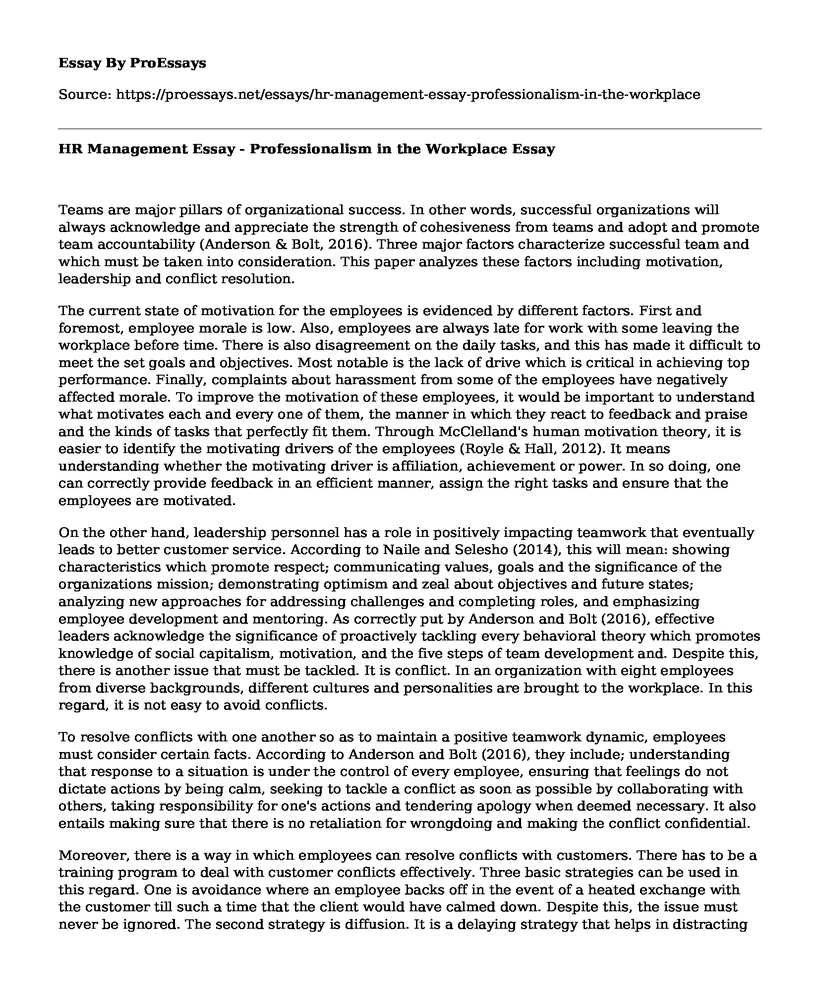Teams are major pillars of organizational success. In other words, successful organizations will always acknowledge and appreciate the strength of cohesiveness from teams and adopt and promote team accountability (Anderson & Bolt, 2016). Three major factors characterize successful team and which must be taken into consideration. This paper analyzes these factors including motivation, leadership and conflict resolution.
The current state of motivation for the employees is evidenced by different factors. First and foremost, employee morale is low. Also, employees are always late for work with some leaving the workplace before time. There is also disagreement on the daily tasks, and this has made it difficult to meet the set goals and objectives. Most notable is the lack of drive which is critical in achieving top performance. Finally, complaints about harassment from some of the employees have negatively affected morale. To improve the motivation of these employees, it would be important to understand what motivates each and every one of them, the manner in which they react to feedback and praise and the kinds of tasks that perfectly fit them. Through McClelland's human motivation theory, it is easier to identify the motivating drivers of the employees (Royle & Hall, 2012). It means understanding whether the motivating driver is affiliation, achievement or power. In so doing, one can correctly provide feedback in an efficient manner, assign the right tasks and ensure that the employees are motivated.
On the other hand, leadership personnel has a role in positively impacting teamwork that eventually leads to better customer service. According to Naile and Selesho (2014), this will mean: showing characteristics which promote respect; communicating values, goals and the significance of the organizations mission; demonstrating optimism and zeal about objectives and future states; analyzing new approaches for addressing challenges and completing roles, and emphasizing employee development and mentoring. As correctly put by Anderson and Bolt (2016), effective leaders acknowledge the significance of proactively tackling every behavioral theory which promotes knowledge of social capitalism, motivation, and the five steps of team development and. Despite this, there is another issue that must be tackled. It is conflict. In an organization with eight employees from diverse backgrounds, different cultures and personalities are brought to the workplace. In this regard, it is not easy to avoid conflicts.
To resolve conflicts with one another so as to maintain a positive teamwork dynamic, employees must consider certain facts. According to Anderson and Bolt (2016), they include; understanding that response to a situation is under the control of every employee, ensuring that feelings do not dictate actions by being calm, seeking to tackle a conflict as soon as possible by collaborating with others, taking responsibility for one's actions and tendering apology when deemed necessary. It also entails making sure that there is no retaliation for wrongdoing and making the conflict confidential.
Moreover, there is a way in which employees can resolve conflicts with customers. There has to be a training program to deal with customer conflicts effectively. Three basic strategies can be used in this regard. One is avoidance where an employee backs off in the event of a heated exchange with the customer till such a time that the client would have calmed down. Despite this, the issue must never be ignored. The second strategy is diffusion. It is a delaying strategy that helps in distracting the customer from the real problem. The conflict with the customer is handled by the employee by delaying the matter to a later date. The complaints should be noted down with a promise to pass them on to the superiors. The last method is a confrontation. This strategy is successful as it tackles the matter head on. One of the best methods to help address the conflict is negotiating with the customer. It helps in balancing the needs of the organization and those of the customers
Finally, different activities help the team progress through the five stages of team development. First, it is important for leaders to establish the mindset and purpose to attain a positive outcome. Achieving a positive outcome starts by having the right attitude. Moreover, there is need to get into every stage with an open mind. With the right behavior and an open mind, there will be an open dialogue which accords all parties the chance to negotiate a deal while creating a harassment-free environment. Most important is that leaders should take situations to the next level and this entails addressing the conflict while presenting the most efficient workplace for all (Anderson & Bolt, 2016). In the end, the object of any organization would be to guarantee the happiness and satisfaction of customers and employees. Considering the adoption of proper training strategies is important not just for the customer, but the organization as a whole.
References
Anderson, L & Bolt, S. (2016). Professionalism: Skills for Workplace Success (4th Ed.). Boston, MA: Pearson.
Naile, I & Selesho, J. (2014). The role of leadership in employee motivation. Mediterranean Journal of Social Sciences, 5(3)
Royle, T & Hall, A. (2012). The Relationship between Mcclellands Theory of Needs, Feeling individually Accountable and Informal Accountability for Others. International Journal of Management And Marketing Research 5(1).
Cite this page
HR Management Essay - Professionalism in the Workplace. (2021, Apr 20). Retrieved from https://proessays.net/essays/hr-management-essay-professionalism-in-the-workplace
If you are the original author of this essay and no longer wish to have it published on the ProEssays website, please click below to request its removal:
- Essay Example on Conflicts in Business Organizations
- Business Ethics and Corporate Social Responsibility in Apple
- Paper Example on Importance of Learning How to Be a Follower
- Statements About Power and Knowledge Paper Example
- Horizon Medical Billing and Coding Case Analysis
- Addiction: A Study of Career Counseling in Relation to Holland and Work Adjustment Theories - Essay Sample
- Paper Example on Contingency Planning: Ensuring Employee Safety in Emergencies







